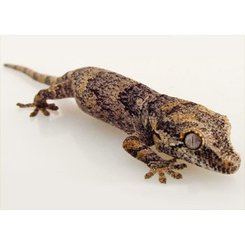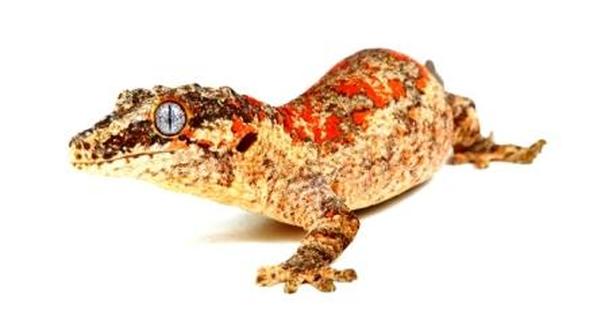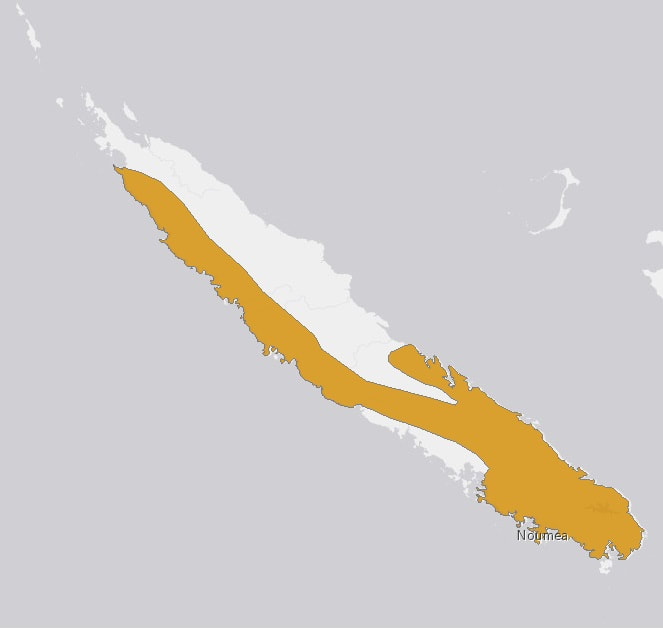Gargoyle GeckoRhacodactylus auriculatus |

Custom Search
|
|
The Gargoyle Gecko (Rhacodactylus auriculatus) also known as the New Caledonian bumpy gecko is only found in the southern regions of the island of New Caledonia.
Located in the southwest Pacific Ocean, New Caledonia is also known as "Grande Terre" and is a special collectivity of France. The island called ‘Grande Terre’ is also known as the “Mainland”, or as "Le Caillou" meaning "The rock" by locals. The Gargoyle gecko is an arboreal species that lives in dense montane forests, humid forests, scrub forests, and open and closed maquis habitats. They aren't usually found far from the forest floor. The species is found along the west coast and central-east coast ultramafic massifs southward to the southern ultramafic block. Like other gecko species endemic to the island, the Gargoyle Gecko isn't commonly found in agricultural and urban environments. They can be found up to 3600 ft (1100 m) high. These are nocturnal reptiles spending their days sleeping. But although they are essentially a nocturnal species, it will occasionally be active by day, staying in the open on tree branches. At night they usually take shelter on the ground beneath dense vegetation or higher up in tree cavities. They can also be very vocal during the night and it's common to hear them bark, squeaking, and growling as they communicate among them.
The Gargoyle Gecko is regarded as a small to medium size gecko and as an adult, they reach an average length of 7 to 9 inches (17 to 23 cm) from snout to vent and weigh 60 to 70 grams.
Usually, they display 2 basic color patterns or "morphs", some individuals are "blotched" while others are "striped". These 2 patterns occur also in a variety of colors, ranging from red, orange, yellow, brown, white, and various shades of gray. The gargoyle gecko is often considered an ideal reptile pet for beginners, with their simple very easy-to-meet requirements. It's also fairly easy to hand tame them because they quickly adapt to human touch. For that reason, they've become very popular and are easily and successfully bred in captivity. Like with most other captive gecko species, they are bred with particular traits of colors and patterns called morphs. These primarily tree dwellers make quite spectacular displays in naturalistic type vivariums. They have a thin prehensile tail which regenerates itself if it drops off, and also as small toe pads. They are capable of gripping vines, branches or other obstacles, for the most part, they are unable to climb sheer surfaces, like glass. Subspecies / Taxonomy / Etymology There are no subspecies for the Gargoyle gecko. The species was first described by Arthur Bavay a French herpetologist pharmacist and malacologist in 1869. These geckoes get their common name from the cranial bumps present in their head, which resemble horns or ears. The species specific name "auriculatus" is the Latin word for "ears" or "eared". Diet / Feeding
In the wild the gargoyle gecko as a similar diet to that of the crested gecko (Rhacodactylus ciliatus). These are omnivore species, they eat lizards even other geckos, insects, small mammals such as rodents, nectar, and fruits. It's a night hunter, searching for prey on shrubs and small trees, on occasion reaching up to 15 m above ground, contrary they are seldom found foraging on the ground. While in captivity they are fed mashed fruits, powdered gecko diet and will also take live food like feeder roaches, waxworms, mealworms, pinkie mice, and crickets. Reproduction Mating can be very rough and most often leads to injuries and loss of the tail. After mating females lay the eggs after around 20 35 days have passed. Females can lay 8 or 9 clutches per year, each one with 2 eggs.The eggs hatch after an incubation period of 60 to 90 days. The hatchlings measure about 1 inch long (2.5 cm) at birth and weigh only 3 grams. Conservation status and major threats The Gargoyle gecko is listed as Least Concern species by the IUCN, because of its wide distribution and presumed large population. Even though their distribution extends for less than 20,000 km2 their estimated population numbers easily surpass the 10 thousand individuals mark. The past illegal trade has been largely reduced since they are easily bred in captivity so the harvest levels from the wild are nowadays quite low. But their natural habitat is threatened by deforestation, wildfires, and the projected expansion of nickel mining. Habitat degradation due to the introduction of pigs and deer and predation by introduced mammals such as rodents, feral pigs are also a threat to these geckoes. Therefore Gargoyle geckos and several other Rhacodactylus species are being considered for inclusion on CITES. This move would put restrictions on their exportation, and give these species some more protection. The species is aLso found in many reserves in Province Sud, but not in any reserves in Province Nord. Currently, there aren't' any undergoing conservation management efforts.
|
Scientific classification
Kingdom: Animalia Phylum: Chordata Class: Reptilia Order: Squamata Family: Diplodactylidae Genus: Rhacodactylus Species: R. auriculatus |



